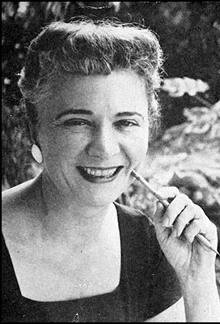
Catherine Lucille Moore was an American science fiction and fantasy writer, who first came to prominence in the 1930s writing as C. L. Moore. She was among the first women to write in the science fiction and fantasy genres. Moore's work paved the way for many other female speculative fiction writers.

Poul William Anderson was an American fantasy and science fiction author who was active from the 1940s until his death in 2001. Anderson also wrote historical novels. He won the Hugo Award seven times and the Nebula Award three times, and was nominated many more times for awards.
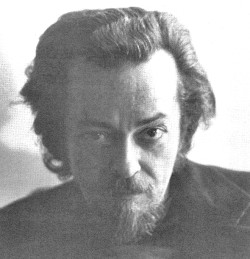
Linwood Vrooman Carter was an American author of science fiction and fantasy, as well as an editor, poet and critic. He usually wrote as Lin Carter; known pseudonyms include H. P. Lowcraft and Grail Undwin. He is best known for his work in the 1970s as editor of the Ballantine Adult Fantasy series, which introduced readers to many overlooked classics of the fantasy genre.

Alan Lee is an English book illustrator and film conceptual designer. He is best known for his artwork inspired by J. R. R. Tolkien's fantasy novels, and for his work on the concept design of Peter Jackson's film adaptations of Tolkien, The Lord of the Rings and The Hobbit film series.

Michael Whelan is an American artist of imaginative realism. For more than 30 years, he worked as an illustrator, specializing in science fiction and fantasy cover art. Since the mid-1990s, he has pursued a fine art career, selling non-commissioned paintings through galleries in the United States and through his website.

John Brian Francis "Jack" Gaughan, pronounced like 'gone', was an American science fiction artist and illustrator and multiple winner of the Hugo Award in the category of Best Professional Artist.

The White Dragon is a science fantasy novel by Irish writer Anne McCaffrey. It completes the original Dragonriders trilogy in the Dragonriders of Pern series, seven years after the second book. It was first published by Del Rey Books in June 1978.

The Shadow of the Torturer is a science fantasy novel by American writer Gene Wolfe, published by Simon & Schuster in May 1980. It is the first of four volumes in The Book of the New Sun which Wolfe had completed in draft before The Shadow of the Torturer was published. It relates the story of Severian, an apprentice Seeker for Truth and Penitence, from his youth through his expulsion from the guild and subsequent journey out of his home city of Nessus.

Flashing Swords! is a series of fantasy anthologies published by Dell Books from 1973 to 1981 under the editorship of Lin Carter, and revived under the editorship of Robert M. Price in 2020. It originally showcased the heroic fantasy work of the members of the Swordsmen and Sorcerers' Guild of America (SAGA), a somewhat informal literary group active from the 1960s to the 1980s, of which Carter was the guiding force. Most of the important sword and sorcery writers at the time of the group’s founding were members; later, membership was extended to other fantasy authors.

The Swordsmen and Sorcerers' Guild of America or SAGA was an informal group of American fantasy authors active from the 1960s through the 1980s, noted for their contributions to the "Sword and Sorcery" kind of heroic fantasy, itself a subgenre of fantasy. When it developed a serious purpose that was to promote the popularity and respectability of Sword and Sorcery fiction.
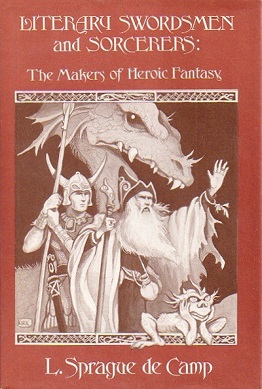
Literary Swordsmen and Sorcerers: The Makers of Heroic Fantasy is a work of collective biography on the formative authors of the heroic fantasy genre by L. Sprague de Camp (1907–2000), first published in 1976 by Arkham House in an edition of 5,431 copies. Nine chapters (2–10) are revisions from a series of ten articles, also titled "Literary Swordsmen and Sorcerers," that initially appeared in the magazine Fantastic and the fanzine Amra between 1971 and 1976. A French edition was issued in May 2010 under the title Les pionniers de la fantasy, and an ebook edition was issued in June 2014 by Gateway/Orion.
Everett Franklin Bleiler was an American editor, bibliographer, and scholar of science fiction, detective fiction, and fantasy literature. In the late 1940s and early 1950s, he co-edited the first "year's best" series of science fiction anthologies, and his Checklist of Fantastic Literature has been called "the foundation of modern SF bibliography". Among his other scholarly works are two Hugo Award–nominated volumes concerning early science fiction—Science-Fiction: The Early Years and Science-Fiction: The Gernsback Years—and the massive Guide to Supernatural Fiction.
The 36th World Science Fiction Convention (Worldcon), also known as IguanaCon II, was held on 30 August–4 September 1978 at the Hyatt Regency Phoenix, Adams House, Phoenix Convention Center, and Phoenix Symphony Hall in Phoenix, Arizona, United States. Despite the name, this was the first "IguanaCon".
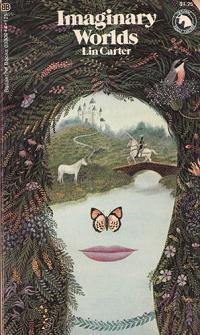
Imaginary Worlds: the Art of Fantasy is a study of the modern literary fantasy genre written by Lin Carter. It was first published in paperback by Ballantine Books in June, 1973 as the fifty-eighth volume of its Ballantine Adult Fantasy series; it was the only nonfiction entry in the series. The book was among the earliest full-length critical works devoted to fantasy writers and the history of fantasy. It was the third of three such studies by Carter, being preceded by Tolkien: A Look Behind "The Lord of the Rings" (1969) and Lovecraft: A Look Behind the "Cthulhu Mythos" (1972). These works, together with his editorial guidance of the Ballantine Adult Fantasy series, established Carter as an authority on the genre.
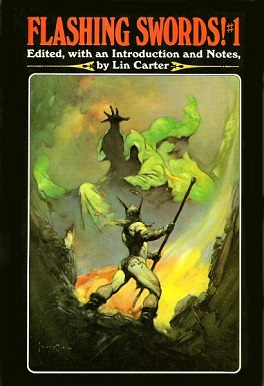
Flashing Swords! #1 is an anthology of fantasy stories, edited by the American writer Lin Carter. It was first published in hardcover by Nelson Doubleday in April 1973 as a selection in its Science Fiction Book Club, and in paperback by Dell Books in July the same year. The first British edition was issued by Mayflower in 1974.

Flashing Swords! #2 is an anthology of fantasy stories, edited by American writer Lin Carter. It was first published in hardcover by Nelson Doubleday in 1973 as a selection in its Science Fiction Book Club and in paperback by Dell Books in February 1974. The first British edition was issued by Mayflower in February 1975.

Flashing Swords! #3: Warriors and Wizards is an anthology of fantasy stories, edited by American writer Lin Carter. It was first published in paperback by Dell Books in August 1976. The first German edition was issued by Pabel in November 1978.
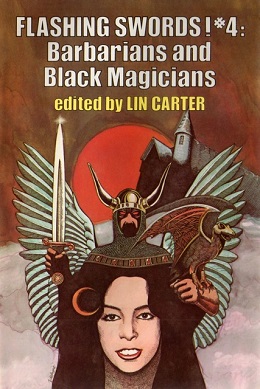
Flashing Swords! #4: Barbarians and Black Magicians is an anthology of fantasy stories, edited by Lin Carter. It was first published in hardcover by Nelson Doubleday in May 1977 as a selection in its Science Fiction Book Club, and in paperback by Dell Books in November 1977.
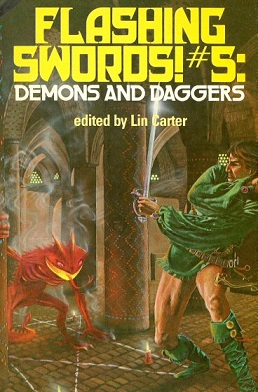
Flashing Swords! #5: Demons and Daggers is an American anthology of fantasy stories, edited by American writer Lin Carter. It was first published in hardcover by Nelson Doubleday in December 1981 as a selection in its Science Fiction Book Club, and in paperback by Dell Books simultaneously.
The Balrog Awards were a set of awards given annually from 1979 to 1985 for the best works and achievements of speculative fiction in the previous year. The awards were named after the balrog, a fictional creature from J. R. R. Tolkien's Middle-earth legendarium. The awards were originally announced by editor Jonathan Bacon in Issue #15 of Fantasy Crossroads and presented at the Fool-Con II convention on April Fool's Day, 1979 at Johnson County Community College, Kansas. The awards were never taken seriously and are often referred to, tongue-in-cheek, as the "coveted Balrog Awards".















